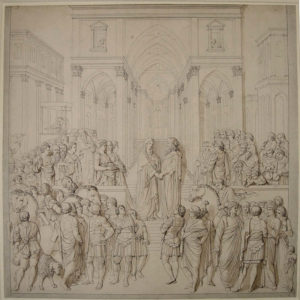 David brought all the tribes together, bequeathing to his son a united nation. Solomon consolidated it—though in the process sowed the seeds for its disruption. Solomon continued his father’s alliance with Hiram of Tyre, and also “made affinity with Pharaoh king of Egypt, and took Pharaoh’s daughter, and brought her into the city of David.” With his frontiers secure, he applied himself to advancing the material prosperity of the country. He mined copper in the southern tip of the Negev. From the nearby port at the head of the Gulf of Aqaba, outlet to the Red Sea, “he made a navy of ships” and, together with his Phoenician ally Hiram, developed a considerable maritime trade. Gold and silver and ivory were brought by sea from Ophir, and formed part of the overland commerce with Israel’s northern neighboring states. Imports from these states were traded for goods from Egypt, linen from that country, horses from Cilicia. Solomon seem to have been the tycoon of the area, or in the more sober phraseology but exaggerated terms of the biblical description, “So king Solomon exceeded all the kings of the earth for riches and wisdom.”
David brought all the tribes together, bequeathing to his son a united nation. Solomon consolidated it—though in the process sowed the seeds for its disruption. Solomon continued his father’s alliance with Hiram of Tyre, and also “made affinity with Pharaoh king of Egypt, and took Pharaoh’s daughter, and brought her into the city of David.” With his frontiers secure, he applied himself to advancing the material prosperity of the country. He mined copper in the southern tip of the Negev. From the nearby port at the head of the Gulf of Aqaba, outlet to the Red Sea, “he made a navy of ships” and, together with his Phoenician ally Hiram, developed a considerable maritime trade. Gold and silver and ivory were brought by sea from Ophir, and formed part of the overland commerce with Israel’s northern neighboring states. Imports from these states were traded for goods from Egypt, linen from that country, horses from Cilicia. Solomon seem to have been the tycoon of the area, or in the more sober phraseology but exaggerated terms of the biblical description, “So king Solomon exceeded all the kings of the earth for riches and wisdom.”
At the center of this trade stood Jerusalem, recipient of its revenues. In the process, the vastly enriched city underwent a great expansion, its physical features matching its economic, political and religious status as the most important site in Israel. To the wealth brought by distant trade was added the labor of the whole nation, both being applied to embellishing Jerusalem with buildings which raised her above every other town in the country.
“In the fourth year of Solomon’s reign over Israel…he began to build the house of the Lord” (I Kings VI, I), and its construction was his most spectacular act. Nothing in the Bible is described in such great detail as the preparations for the actual building of this Temple.
The site chosen was the highest spot on the hill-city, the “threshing floor of Araunah the Jebustie” (II Samuel XXIV), which King David had insisted on buying and for which he had paid “fifty shekels of silver.” He thus acquired ownership of the land on which he himself erected an altar and upon which his son Solomon would later erect the permanent shrine. It was located to the north of the city compound as it existed in David’s day, where it stood within its own huge court. Tradition associates this site with Mount Moriah, scene of Abraham’s would-be sacrifice of Isaac, and to this day the Temple Mount is also referred to as Mount Moriah.
Below the Temple (but also on high ground, believed to be Mount Ophel), and separated from it by a wall, rose another formidable building, the “House of the King;” and below that, Solomon constructed a large complex of royal buildings. They are described in I Kings VII. From these biblical details and from the contours of the site, we can recapture the appearance of this handsome cluster of structures, and a truly imposing spectacle they must have presented. On the highest point of the hill-city loomed the Temple, surrounded by its huge court. Below it, in a series of terraces and standing in their own courts, rose the royal palace and the “house for Pharaoh’s daughter;” the “porch of pillars;” the “porch for the throne;” and the large “house of the forest of Lebanon,” so named, presumably because its cedar beams rested upon forty-five pillars also of cedar wood brought from the Lebanon. The latter buildings served as the business quarters of the palace, offices where state affairs were conducted, assembly rooms, and the hall where Solomon sat in judgment. In addition to the walled courts in each of the terraces, the entire complex was encircled by a strong wall of stone, so that it must have appeared as a separate citadel in Jerusalem.
There are only fragmentary references to Solomon’s work on the fortifications of the city, nothing beyond the fact that he built “the wall of Jerusalem round about”—we cannot trace its line—and that he also “built Millo, and repaired the breaches of the city of David.” Millo, as we have already indicated, may have been the area between the Temple compound and David’s city. There is no clue as to what and where the breaches were that he repaired.